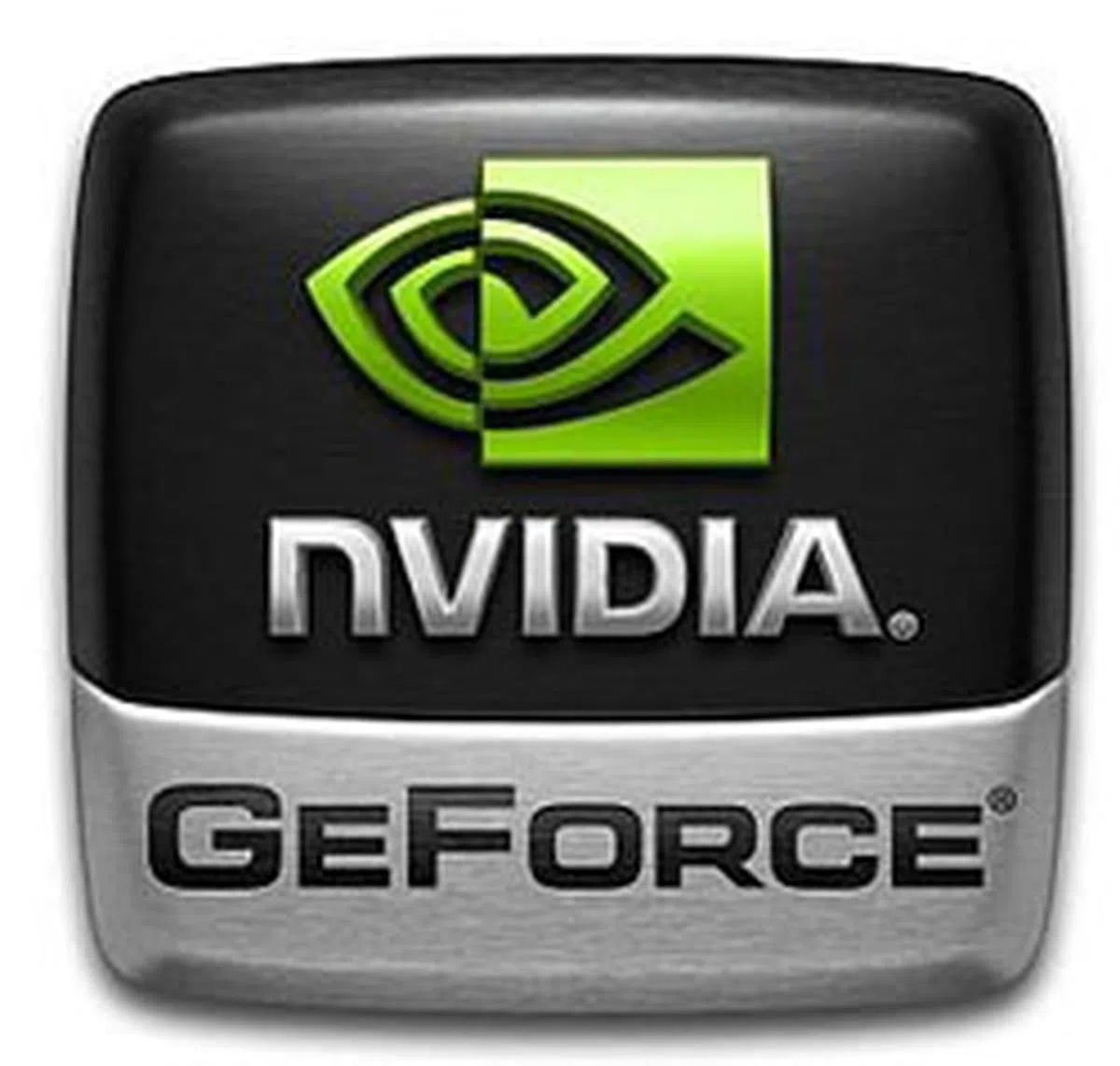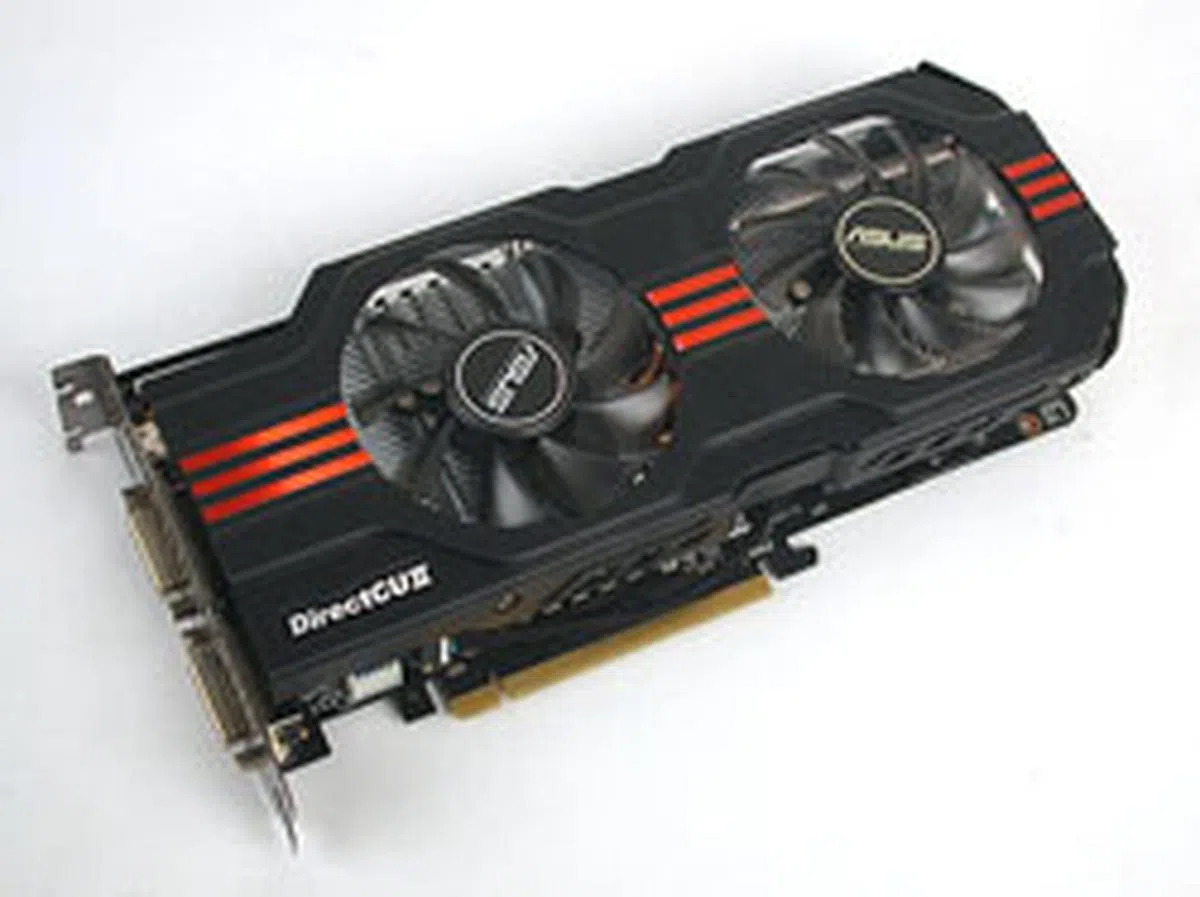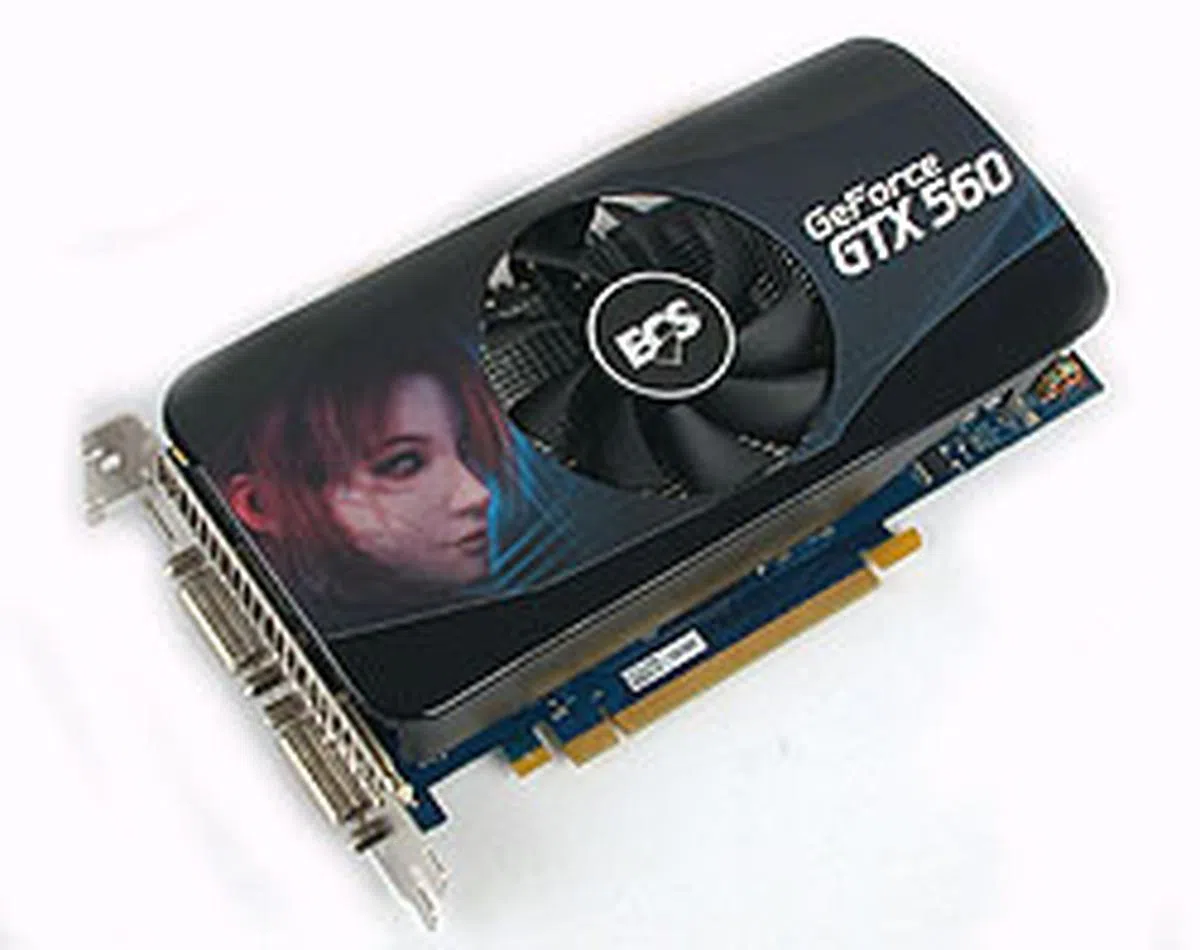NVIDIA GeForce GTX 560 - Plugging the Mainstream Gap
NVIDIA started 2011 with a bang when it introduced the GTX 560 Ti. Now, the company has followed up with the GTX 560, the successor to the phenomenal GTX 460. Can the new GPU plug the hole in NVIDIA's lineup between the 560 Ti and the 550 Ti?
A Card for Every Price Point
The return of the 'Ti' branding on the NVIDIA , launched at the start of the year, heralded a more competitive NVIDIA. After a slow start to 2010, NVIDIA had arguably turned the corner with the debut of the GTX 460 and the green team has grown in strength since.
The company has since rejuvenated its mainstream offerings, with the that followed the 560 Ti. NVIDIA also managed the time to blast out the to counter AMD's Radeon HD 6990. Not forgetting the latest entry level 500 series models like the GT 520 and NVIDIA can state confidently that it has refreshed its entire range of graphics cards.
But as we mentioned in our 550 Ti roundup, there is quite the performance (and price) gap between the NVIDIA 550 Ti and the 560 Ti, which brings us to today's inevitable new SKU, the GeForce GTX 560. Equipped with a similar GF114 core, the new GTX 560 has 336 CUDA cores or stream processors compared to the 384 on the Ti version. This also meant a decrease of eight texture filtering units, thereby creating a GPU that falls between the 560 Ti and the 550 Ti.
With the GTX 560 Ti the successor to the GTX 470, it's only natural that the new GTX 560 will be considered the heir to the phenomenally successful GTX 460. Those are big shoes to fill however and we'll see if the new SKU manages that.
NVIDIA is also giving free rein to its board partners to set the clock speeds, with a rather wide range of core clocks deemed acceptable. This means one will probably find a range of speeds from 810MHz to 950MHz, though NVIDIA believes that the majority of GTX 560 in the market will be in the upper range. As a result, the prices too will be spread over a range, which is useful considering the almost US$100 price gap between the US$250 560 Ti and the US$150 550 Ti.

We got three graphics cards from ASUS, ECS and Palit, all at different clock speeds. You definitely want to check the clock speeds on this SKU before putting down the cash.
As it is, the GeForce GTX 560 starts from US$199 and with its similarity to the GeForce GTX 560 Ti, you can expect a performance level closer to the 560 Ti. We also expect the major board partners to have their products ready for launch. This definitely won't be a paper launch. For your reference, we have included the specifications for the new GTX 560, along with that of its closest competitors.
Model | NVIDIAGeForce GTX 560 | NVIDIAGeForce GTX 560 Ti | NVIDIA GeForce
GTX460 | NVIDIAGeForce
GTX 470 | AMDRadeon HD 6870 | AMDRadeon HD6850 | ATI Radeon HD 5850 |
Core Code | GF114 | GF114 | GF104 | GF100 | Barts XT | Barts PRO | Cypress Pro |
Transistor Count | 1950 million | 1950 million | 1950 million | 3200 million | 1700 million | 1700 million | 2150 million |
Manufacturing Process | 40nm | 40nm | 40nm | 40nm | 40nm | 40nm | 40nm |
Core Clock | 810 to 950MHz | 822MHz | 675MHz | 607MHz | 900MHz | 775MHz | 725MHz |
Stream Processors | 336 Stream Processors | 384 Stream Processors | 336 Stream Processors | 448 Stream Processors | 1120 Stream processing units | 960 Stream processing units | 1440 Stream processing units |
Stream Processor Clock | 1620 to 1900MHz | 1644MHz | 1350MHz | 1215MHz | 900MHz | 775MHz | 725MHz |
Texture Mapping Units (TMU) or Texture Filtering (TF) units | 56 | 64 | 56 | 56 | 56 | 48 | 72 |
Raster Operator units (ROP) | 32 | 32 | 24 | 40 | 32 | 32 | 32 |
Memory Clock | 4008MHz GDDR5 | 4008MHz GDDR5 | 3600MHz GDDR5 | 3348MHz GDDR5 | 4200MHz GDDR5 | 4000MHz GDDR5 | 4000MHz GDDR5 |
DDR Memory Bus | 256-bit | 256-bit | 192 / 256-bit | 320-bit | 256-bit | 256-bit | 256-bit |
Memory Bandwidth | 128GB/s | 128GB/s | 86.4 / 115.2GB/s | 133.9GB/s | 134.4GB/s | 128GB/s | 128GB/s |
PCI Express Interface | PCIe ver 2.0 x16 | PCIe ver 2.0 x16 | PCIe ver 2.0 x16 | PCIe ver 2.0 x16 | PCIe ver 2.0 x16 | PCIe ver 2.0 x16 | PCIe ver 2.0 x16 |
Molex Power Connectors | 2 x 6-pin | 2 x 6-pin | 2 x 6-pin | 2 x 6-pin | 2 x 6-pin | 1 x 6-pin | 2 x 6-pin |
Multi GPU Technology | SLI | SLI | SLI | SLI | CrossFireX | CrossFireX | CrossFireX |
DVI Output Support | 2 x Dual-Link | 2 x Dual-Link | 2 x Dual-Link | 2 x Dual-Link | 1 x Single-Link, 1 x Dual-Link | 1 x Single-Link, 1 x Dual-Link | 2 x Dual-Link |
HDMI | 1 (mini-HDMI) | 1 (mini-HDMI) | 1 (mini-HDMI) | 1 (mini-HDMI) | 1 | 1 | 1 |
DisplayPort | None | None | None | None | 2 (DisplayPort 1.2) | 1 (DisplayPort 1.2) | 1 |
HDCP Output Support | Yes | Yes | Yes | Yes | Yes | Yes | Yes |
Street Price | Launch price: from US$199 | ~US$250 | ~US$170 to 190 | ~US$205 | ~US$200 | ~US$170 | ~US$190 |
ASUS ENGTX560 DCII TOP
With a core clock of 925MHz and a memory frequency of 4200MHz DDR, the ASUS ENGTX560 DCII TOP justifies its billing by being the fastest of the three GTX 560 in today's roundup. Equipped with ASUS' DirectCU II cooling system, notable for the dual-fans, copper heatpipes that are in direct contact with the GPU core (hence the name) and an extensive array of heatsink fins, this ASUS card is the heavyweight among the three. We expect great things from this card, based on our experience with the 560 Ti version.

The GeForce GTX 560 gets the DirectCU II treatment from ASUS. With its huge, dual-fan cooler to support its overclocked frequencies, we expect a speedy and cool performance.

The standard dual-slot design with two DVI outputs and a mini-HDMI.

Thankfully, the power connectors on this card are such that you connect them from the top, and not aligned at the extreme end of the card.

Due to its large cooler and the heatsinks underneath, this is a hefty card.
ECS GeForce GTX 560
The slowest of the trio, the ECS GeForce GTX 560 is clocked at the lowest possible clock speed mandated by NVIDIA. This means a core clock of 810MHz, with the memory frequency at 4008MHz DDR. With 1GB of GDDR5 memory, this appears to be a standard configuration for this SKU and ECS has done little to suggest otherwise. The card looks a bit like the reference GTX 560 Ti, though the dual heatpipes on this card appear to be thicker and larger than the reference.

The specifications for this ECS card are the bare minimum for its SKU. It features a fan at the center, similar to the GTX 560 Ti.

Again, the same set of outputs which includes two DVI and the mini-HDMI.

Unlike the ASUS, the power connectors are aligned such that one has to connect them via the front of the card. It's no big deal if you have a large, spacious chassis, or a relatively short card like this ECS GeForce GTX 560.

Twin, thick heatpipes help to conduct the heat away from the GPU core.
Palit GTX 560 Sonic Platinum
We're not strangers either to Palit's graphics cards, but unlike the 560 Ti Sonic that came with dual fans, this Sonic Platinum only gets a single fan. That doesn't mean Palit has cut back on the clock speeds however, as this Sonic Platinum is still clocked at a speedy 900MHz, with the same memory frequency as the ASUS. Due to Palit's custom PCB, which is shorter than the reference design, this is one card that will fit in cases where space is at a premium.

It's now one fan instead of the two we saw on Palit's 560 Ti Sonic.

Palit has gone for a different configuration, adding in a VGA output at the expense of the DVI.

The two 6-pin power connectors on the Palit are aligned facing the top.
Test Setup
We’ll be evaluating the three cards using our Intel X58 testbed which has the following specifications:
- Intel Core i7-975 (3.33GHz)
- Gigabyte GA-EX58-UD4P motherboard
- 3 x 1GB DDR3-1333 G.Skill memory in triple channel mode
- Seagate 7200.10 200GB SATA hard drive
- Windows 7 Ultimate
?We didn't actually get a 'reference' GTX 560 from NVIDIA, but given the range of clock speeds allowed, there is perhaps no such thing as reference clocks. Hence, we'll be looking at the three custom models from ASUS, ECS and Palit, each with a different clock speed. We'll see if the fancy coolers on the ASUS and Palit cards help in the overclocking and the cooling portion.
For comparison, we have thrown in some of the old and new graphics cards that can compete with the GTX 560. Obviously, the GTX 560 Ti will be included in our results as the next faster NVIDIA card of this generation. The older GTX 460 and 470 are also included. From AMD, we felt that the 6870 and 6850 provide good data points to judge the GTX 560 while the old but gold 5850 may yet prove to be a surprise package.
Here’s a quick summary of the cards’ clock speeds.
Cards | Core Clock Speed | Shader Clock Speed | Memory Clock Speed |
ASUS ENGTX560 DCIITOP | 925MHz | 1850MHz | 4200MHz DDR |
ECSGeForce GTX560 | 810MHz | 1620MHz | 4008MHz DDR |
Palit GTX560 Sonic Platinum | 900MHz | 1800MHz | 4200MHz DDR |
The full list of cards tested and driver versions used:
- ASUS ENGTX 560 DCII TOP (ForceWare 270.48)
- ECS GeForce GTX 560 (ForceWare 270.48)
- Palit GTX 560 Sonic Platinum (ForceWare 270.48)
- NVIDIA GeForce GTX 560 Ti (ForceWare 266.56 )
- NVIDIA GeForce GTX 460 (ForceWare 263.09)
- NVIDIA GeForce GTX 470 (ForceWare 263.09)
- AMD Radeon HD 6870 (Catalyst 10.12)
- AMD Radeon HD 6850 (Catalyst 10.12)
- AMD Radeon HD 5850 (Catalyst 10.9)
The full list of benchmarks used:
- Futuremark 3DMark Vantage
- Futuremark 3DMark 11
- Crysis Warhead
- Far Cry 2
- Warhammer: Dawn of War 2
- Battlefield Bad Company 2
- “Heaven" from Unigine v2.1
- S.T.A.L.K.E.R.: Call of Pripyat
3DMark 11 and 3DMark Vantage Results
We started our benchmarking with the new 3DMark 11 utility. Immediately, the competitive performance of the ASUS and Palit GTX 560 stood out, as they managed to beat the reference GTX 560 Ti. With the relatively high clock speeds of the ASUS and Palit GTX 560, it's perhaps not that surprising that they can compete with the Ti.
The ASUS ENGTX560 DCII TOP, which had the fastest clock speeds on paper, also gave the Radeon HD 6870 quite the fight. That's good news for NVIDIA, as the Radeon HD 6870 is now going for around US$200, which means that it falls in the same price bracket as the new GTX 560. Of course, one will expect the ASUS to have a slight premium over the standard GTX 560, due to its custom cooler and higher clock speeds.

Like in 3DMark 11, we found the Vantage scores of the GTX 560 cards to be very competitive with the GTX 560 Ti. The ECS GeForce GTX 560 was the exception of the rule, but given that it has one of the slowest possible core clock speeds for a GTX 560, it does bode well for the new SKU, especially from the way the GTX 560 performed against the Radeon HD 6870. If one compares the slowest ECS against the previous generation, it also looks positive for NVIDIA, with the newcomer edging ahead of the GTX 470. One can hardly argue that there has been no progress.

Crysis Warhead & Far Cry 2 Results
While the faster GTX 560 cards remained competitive with the reference GTX 560 Ti in Crysis Warhead, the slowest ECS GeForce GTX 560 was losing to the Radeon HD 6870 and the GTX 470. Since we can expect a range of clock speeds for this SKU, it becomes very important to check the clock speeds before purchasing. Owners of the Radeon HD 5850 will also find little reason to upgrade, as it matched the ECS here.


The NVIDIA cards streaked away from the AMD contingent in Far Cry 2. Again, the higher clocked GTX 560 cards from ASUS and Palit are almost equal to the GTX 560 Ti, but there was a roughly 10% difference between the ASUS and the ECS GTX 560.


Dawn of War 2 & Battlefield Bad Company 2 Results
We aren't exactly sure what happened in Dawn of War II, which saw all the GTX 560 cards returning half the frame rates of its competing SKUs, but we have a reasonable explanation. As the GTX 560 shares the same core as the 560 Ti, we can only deduce that the newer driver that we used for the GTX 560 is the reason for the disparity.

In a reverse of the Dawn of War II situation, we saw all the GTX 560 cards beating even the GTX 560 Ti in Battlefield Bad Company 2. Although the margins were quite significant, we'll have to chalk this to a driver-related performance boost as until now, the GTX 560 Ti had held its own.

Unigine "Heaven" 2.1 Results
NVIDIA's advantage in tessellation heavy benchmarks is most evident in Unigine's DirectX 11 results, where all the NVIDIA cards were significantly faster than the AMD cards. The GTX 560 cards here were no different and they continued their fine form, with the ASUS and Palit threatening the reference GTX 560 Ti. The GTX 470 in fact was very competitive in this segment, no doubt thanks to its superior number of stream processors. However, the new generation is showing that clock speeds can go some way to compensating for this.
DirectX 11 Results


DirectX 10 Results


S.T.A.L.K.E.R.: Call of Pripyat Results
DirectX 11 was once again a strength of NVIDIA's current architecture, with the NVIDIA cards performing better in these runs. This was the reverse for the AMD cards, which fared better in the DirectX 10 runs without tessellation. Between the NVIDIA cards, the GTX 560 cards continued to impress, with scores that beat the default GTX 560. The GeForce GTX 470 was also a contender for the DX11 runs, which as we mentioned before, was a result of its 448 stream processor count against the 336 and 384 on the GTX 560 and the 560 Ti respectively.
The ASUS and Palit GTX 560 cards continued to lead the way, with the ECS GTX 560 lagging behind. On the bright side, the ECS had almost identical scores as the GeForce GTX 560 Ti.
DirectX 11 Results
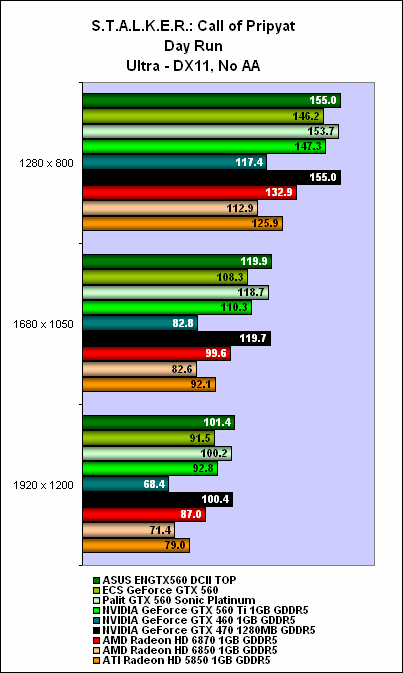 |  |
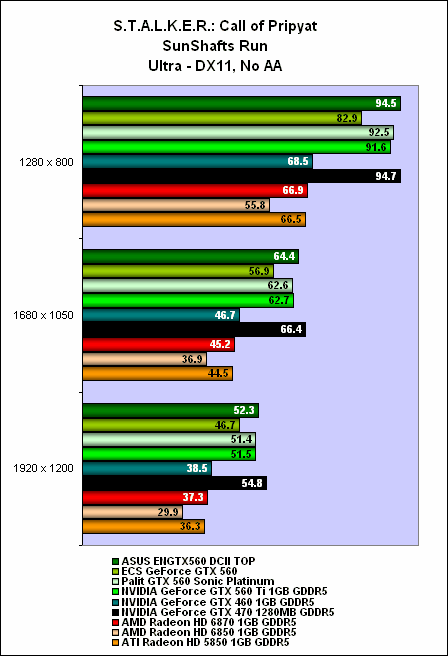 | 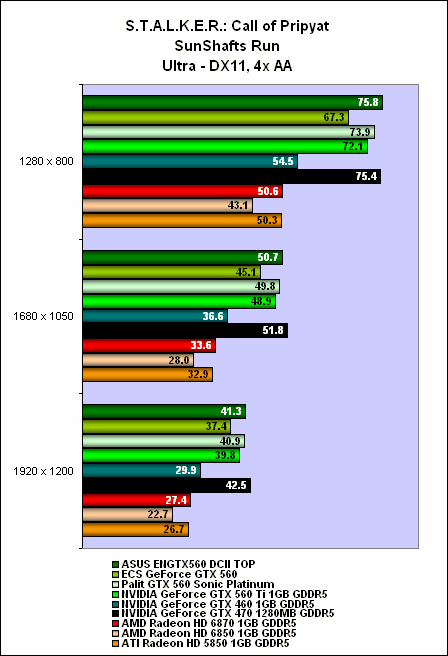 |
DirectX 10 Results
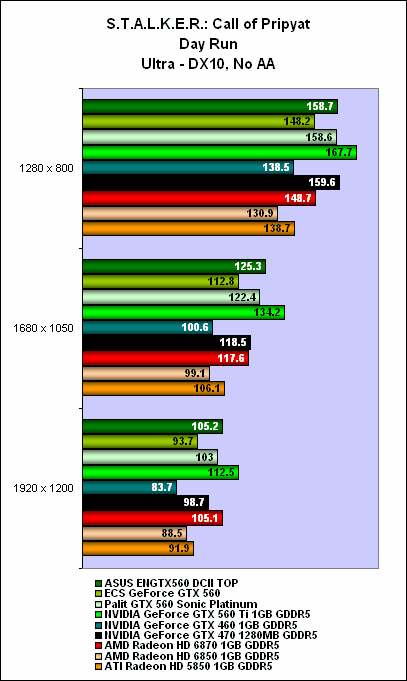 | 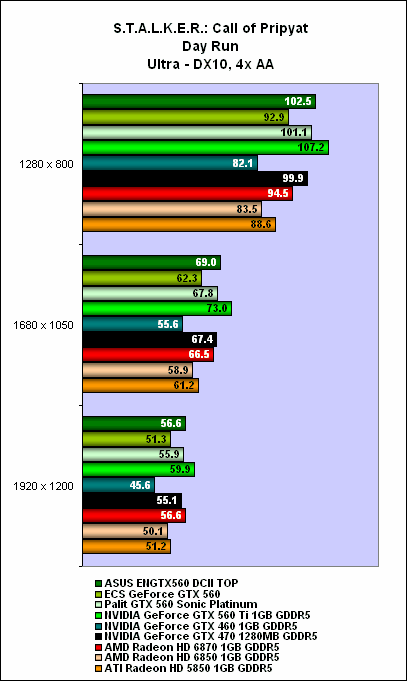 |
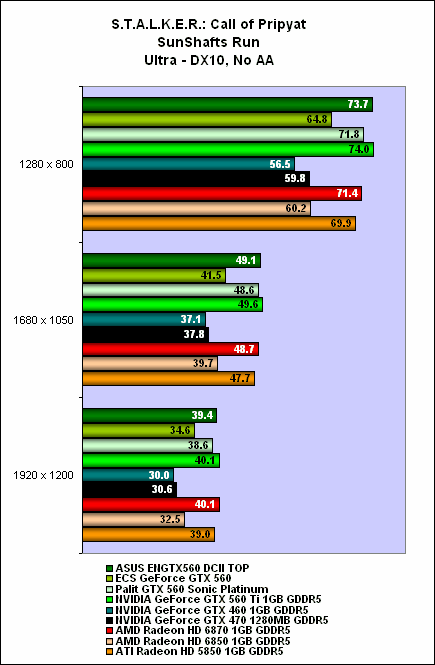 | 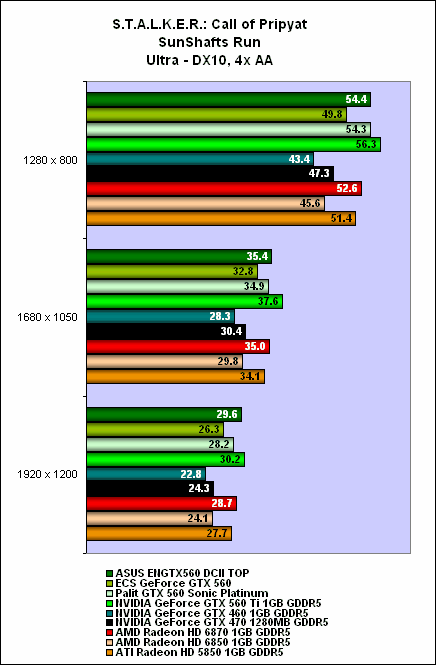 |
Temperature
The DirectCU II cooler on the ASUS paid dividends here with the lowest temperatures recorded for all the graphics cards compared. ECS' simple and plain design also helped it clinch the second spot among the GTX 560 cards, but its significantly lower clock speeds probably contributed to that. All three cards had relatively quiet coolers that will not be audible in a typical usage scenario.

Power Consumption
With less stream processors, we expected the GTX 560 to consume less power than the 560 Ti and that was indeed the case. All three GTX 560 cards recorded an identical 90W total system draw at idle, with the Palit Sonic Platinum drawing slightly more power than the other two at peak. Considering the generally higher clocks on the 560 compared to the 560 Ti, the peak power draw numbers seem about right.

Overclocking
We had a small surprise in the overclocking test, with the ECS GeForce GTX 560 punching way above its weight with a maximum core clock of 940MHz, a big jump from its default 810MHz. The memory frequency too reached up to 5000MHz DDR from 4008MHz DDR. Overall, this helped it edge ahead of the ASUS, which despite boasting of a superior cooler, managed a lower memory clock of 4300MHz DDR. Both cards however were trumped by the Palit, which had the best core clock of 960MHz and an equally high 5000MHz DDR for the memory.
We had already seen the faster GTX 560 models in our roundup competing well with the default 560 Ti, so it's only expected that when overclocked, they would exceed the 560 Ti. All three GTX 560 cards in fact beat the reference GTX 560 Ti narrowly.

Plugging the Gap
The GeForce GTX 460 was an important GPU. Its successor, the new GTX 560, will not have a similar impact. While the highly successful GTX 460 answered the critics that doubted NVIDIA's ability to churn out a mainstream Fermi part, the GTX 560 has no such lofty expectations resting on its shoulders. If anything, its thunder has been stolen at the beginning of the year by the, which showed that NVIDIA was continuing to refresh its GTX 500 series lineup with increasingly affordable and competitive SKUs. The new GeForce GTX 560 on the other hand is but an attempt to close a gap in the market, what with NVIDIA slowly phasing out its GTX 400 series GPUs.
With a similar core as the GTX 560 Ti, but with fewer stream processors, the GTX 560 nevertheless impressed us with how competitive it was. No doubt, our perceptions were affected by the two extremely high-speed, custom GTX 560 that we got from ASUS and Palit. The ECS GTX 560 that was the other card we received had more modest clocks and was hence distinctly behind the reference GTX 560 Ti in most benchmarks.
Even then, we can say for a certainty that the GTX 560 is much closer to the GTX 560 Ti despite falling directly in between the GTX 550 Ti and the 560 Ti in terms of pricing. Part of the reason is the relatively high core clocks that we are seeing on the GTX 560, with NVIDIA claiming that most of them will be in 850 to 950MHz range. Of course, we're not including the many overclocked GTX 560 Ti in the market that will tilt the advantage the other way.
Since NVIDIA has allowed its board partners free rein over the clock speeds, with a variable core clock range of more than 100MHz, it's even more important to get the clock speeds right when getting one of these cards. We saw a difference of more than 10% between the fastest and the slowest GTX 560 cards and there could be even faster ones than the ASUS.
In our minds, there's no doubt that these GTX 560 cards will be popular in the market - the starting price of US$199 (for the lower clocked models) almost guarantees it. AMD currently has the Radeon HD 6870 1GB in direct competition with the GTX 560 at this price range, but from our benchmarks, it's likely that the NVIDIA cards will prevail, especially in tessellation-heavy games. It's back to AMD now, as we'll find out if the company has a suitable riposte later this year.
As for the three custom GTX 560 cards we saw this in roundup, the ASUS ENGTX560 DCII TOP came with the highest clock speeds and undoubtedly the best cooler. The temperature tests confirmed that, though to our surprise, its overclocking allowance was not as impressive. At S$399, it's also quite likely to be the most expensive. The Palit GTX 560 Sonic Platinum also had very competitive clock speeds, but you will probably have to manage with higher temperatures than the standard design that the ECS GTX 560 represents. (Edit: we just got the price for the Sonic Platinum and like we had expected, Palit has priced it at a very competitive S$319, making it a great value for consumers.)
In fact, the ordinary looking ECS was the surprise package, thanks to a very good overclocking performance. It also scored well in the temperature testing, but its slower clock speeds won't be winning too many awards. ECS informed us that its price is US$199, making it the baseline for the prices of the GTX 560. All three cards have their own merits so our advice is to get one that fits your budget and needs, which given the variance in clock speeds, seems quite easy. And double-check the clock speeds before making the purchase.
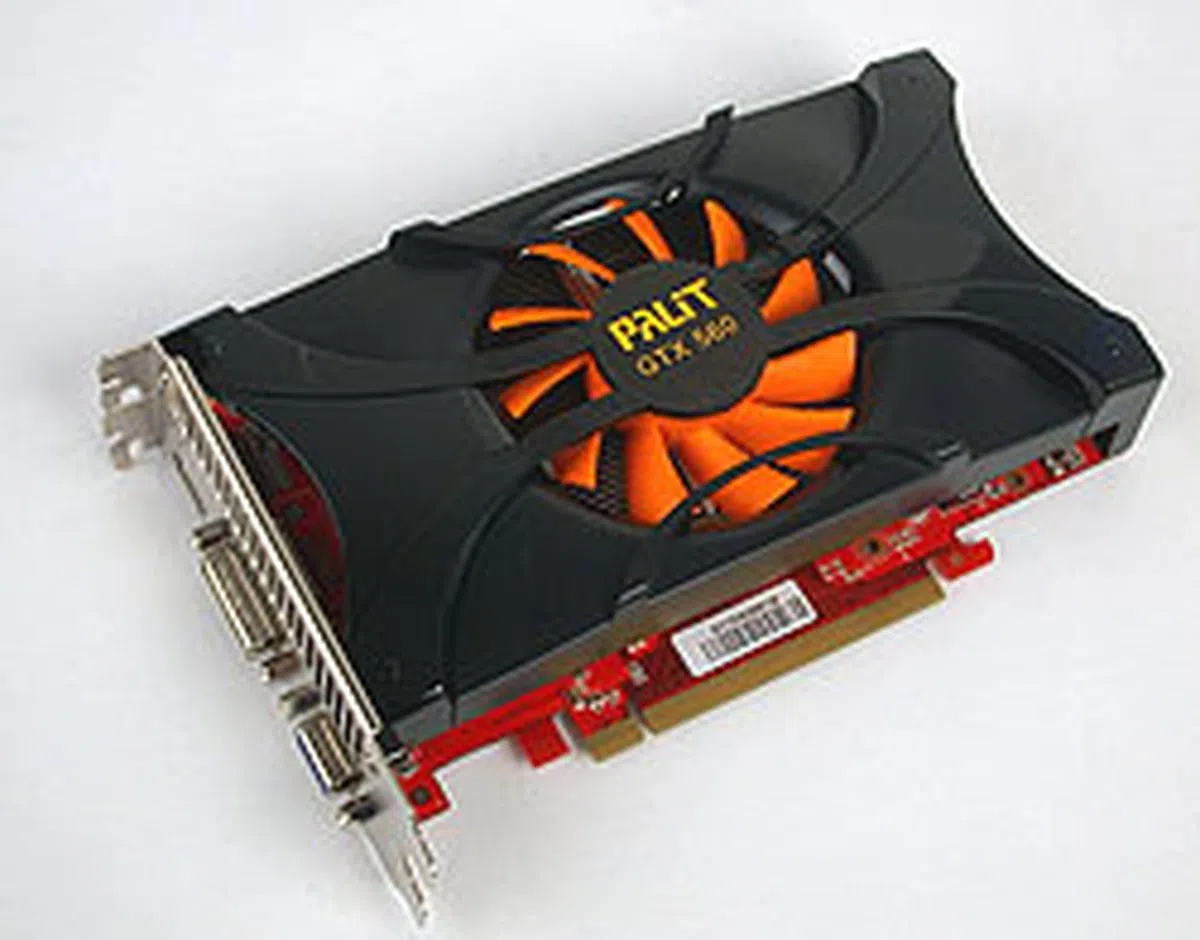 | 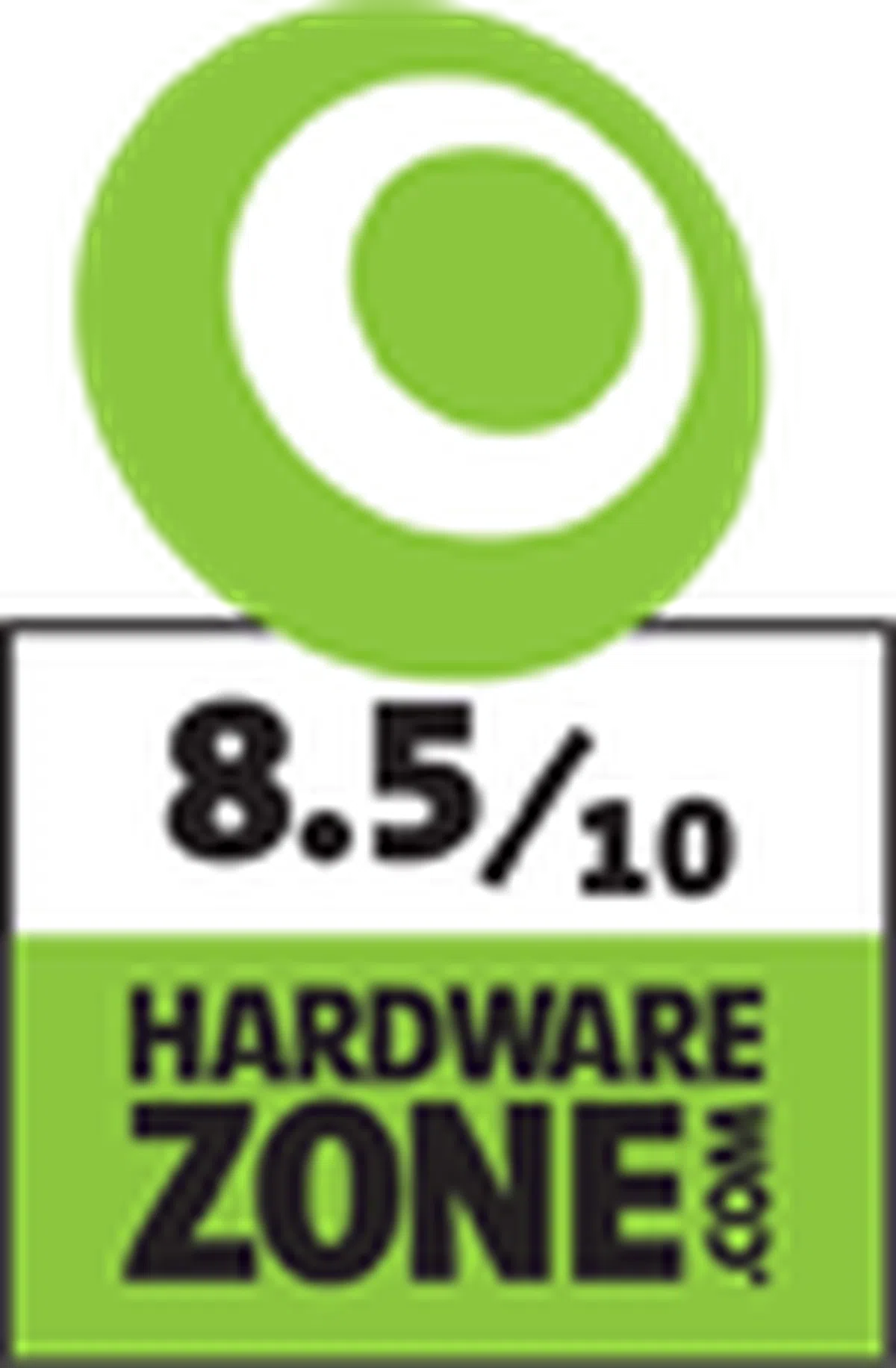 |
| 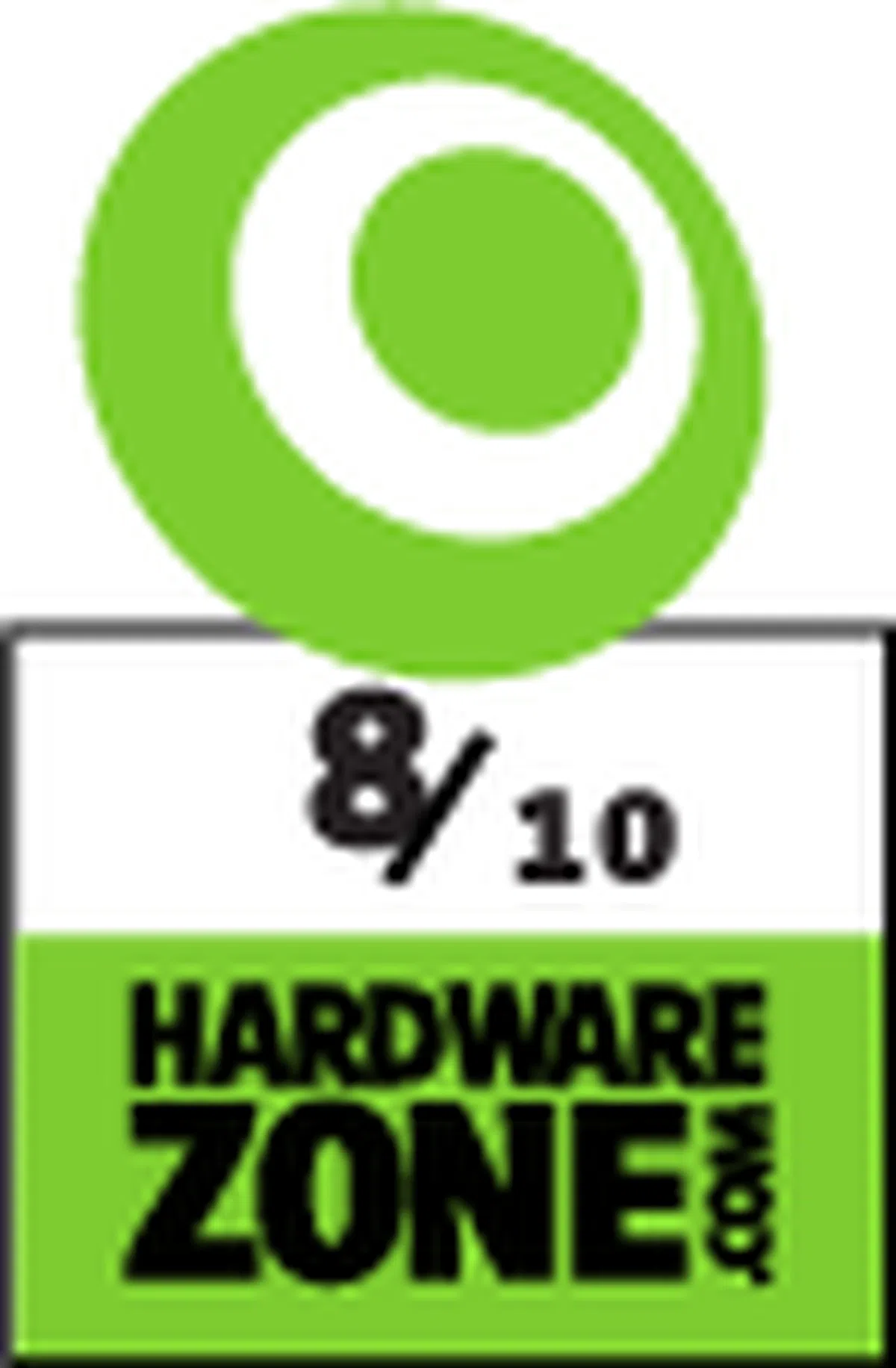 |
|  |
Our articles may contain affiliate links. If you buy through these links, we may earn a small commission.
